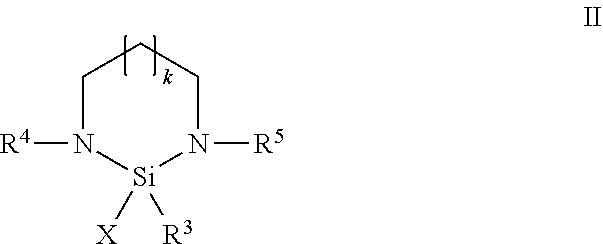Functionalized polymer, rubber composition and pneumatic tire
a technology of functionalized polymers and rubber compositions, applied in the field of functionalized polymers, can solve the problems of low polymer hysteresis and provide a lower level of tire rolling resistance, and achieve the effects of improving the affinity of fillers, improving the interaction of polymer/filler, and low cos
- Summary
- Abstract
- Description
- Claims
- Application Information
AI Technical Summary
Benefits of technology
Problems solved by technology
Method used
Image
Examples
example 1
[0067]In this example, synthesis of bis(dimethylamino)chloromethylsilane is illustrated. In a 100 mL Schlenk flask, 35 ml (0.3 mol) of trichloromethylsilane were diluted with THF, followed by the addition of 4.0 eq dimethylamine (600 ml, 2M solution in THF) in a 0° C. bath. The reaction was stirred for 4 hours, filtered and concentrated under reduced pressure. The concentrated product solution was distilled to give 34 g of bis(dimethylamino)methylchlorosilane as a colorless liquid, boiling point: 72-74° C., 80 Torr. 1H NMR structures matches known material.
example 2
[0068]In this example, termination of a polymerization reaction with a terminator of the invention is illustrated. To a 4 oz bottle was charged 60 g of 15 wt % butadiene in hexane solution followed by 41 μl 2,2-di-tetrahydrofuryl propane (DTP, 1 eq) and 95 μl of 2.5 M n-BuLi / hexanes solution. The mixture was tumbled in a 65° C. water bath for 30 min, and then 0.24 mmol (1.1 eq to Li) of the aminochlorosilane prepared in Example 1 was added with additional reaction at 65° C. for another 35 mins. An analogous control polymerization was done with trietthoxymethyl silane (TEMS) in place of the aminochlorosilane The resulted polymer was quenched with 0.1 ml degassed methanol and sampled for characterization. Coupling weight percentage and Mn was measured by GPC, the functionalization percentage of reacted chain end was measured by proton NMR, with results given in Table 1.
[0069]As seen in Table 1, the percentage of functionalized single polymer chains significantly improves with the inve...
PUM
| Property | Measurement | Unit |
|---|---|---|
| particle diameter | aaaaa | aaaaa |
| temperatures | aaaaa | aaaaa |
| temperatures | aaaaa | aaaaa |
Abstract
Description
Claims
Application Information
 Login to View More
Login to View More - R&D
- Intellectual Property
- Life Sciences
- Materials
- Tech Scout
- Unparalleled Data Quality
- Higher Quality Content
- 60% Fewer Hallucinations
Browse by: Latest US Patents, China's latest patents, Technical Efficacy Thesaurus, Application Domain, Technology Topic, Popular Technical Reports.
© 2025 PatSnap. All rights reserved.Legal|Privacy policy|Modern Slavery Act Transparency Statement|Sitemap|About US| Contact US: help@patsnap.com



